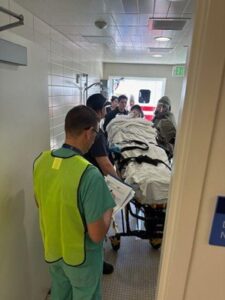As emergency physicians, everyday is spent helping others who are going through a struggle and have turned to us for help. We’re ready for anything at any time, whether it be a true medical emergency or addressing the psychosocial stressors for those who have nowhere else to seek assistance. While we face many difficult encounters and challenging cases, one of my biggest fears has been a mass casualty incident (MCI). Whether it be an earthquake (hello Wasatch Fault), train derailment, active shooter event or a climate-related disaster, our communities will no doubt turn to us in the emergency department as a place for help, both medical and non-medical.

While part of me wanted to continue to neglect that this may ever happen in Utah, after talking with several colleagues on shift we decided the better approach would be to face our fears head-on. To better prepare for these situations our group, Utah Emergency Physicians, worked with the Intermountain Health ED Trauma-Operations Lane as well as the Intermountain Center for Disaster Preparedness (ICDP) to create a multi-phased training experience for ED physicians including a didactic segment as well as in-situ simulation training in each of our 6 departments.
Objectives
- Understand your Hospital Surge plans and appreciate differences of large and small facilities
- Describe the changes in triage, registration, patient movement, and patient care processes
- Learn about the role of the ED Lead Physician
- Global Assessment
- Decompress Department
- Prep for Surg
- Communication
- Learn about the role of the ED Triage Director
- Spot Check w/ Emphasis on the 3 D’s
- Danger, Decon, Dying
- Dynamic Decision Making

- Spot Check w/ Emphasis on the 3 D’s
Didactic Learning
- Utilize ACEP Resources including the Department of Homeland Security/FEMA Hospital Disaster Preparedness Self-Assessment Tool.
- Engagement with multidisciplinary physicians who have been through these events from the Las Vegas Shooting to the Boston Marathon Bombing to learn from their experiences.
- By far, the biggest takeaway from those who have been through these experiences is that having done any prior training will no doubt make you and your entire hospital be more prepared.
- We then created a video for our physicians & APP’s to watch on their own time with the above physician testimonials as well as an overview of our department and hospital system’s disaster preparedness plan.
In-Situ Events
- Working with the Intermountain Simulation Consortium alongside the ICDP, we developed our scenario with core high-fidelity simulation cases. We then supplemented with variable numbers of low-fidelity live actor patients as well as low-fidelity manikins to tailor the stress on each of our departments.
- Low was 10 patients, high was 47 patients
- High-Fidelity Cases
- Tox/Chemical Exposure requiring decon
- Chest Pain w/ STEMI
- Trauma – Crush Injury to L chest/abd with L femur Fx
- Peds Trauma – Blunt head injury
- We then collaborated with local EMS agencies who would bring patients in standard fashion as well as having patients arrive via private vehicle for dual-points of entry.
- Emergency physicians and ED staff were then challenged with activating appropriate hospital surge plans and waterfall lists for staffing resources, as well as engaging with physicians from other services and hospital administration to move patients through the ED.
- Engagement with the hospital registration services for rapid triage, security services to control entrances, case management services to help with patient and family needs, environmental services to address room turnover, blood bank and lab services, radiology, administration amongst a host of other service lines.
Patients were triaged and required stabilization and treatment interventions prior to being transported out of the department.
Debrief & Takeaways
The real learning took place during our debrief sessions, where we were able to address specific strengths as well as identify points of weakness. From a physician and frontline resuscitationist standpoint, our key take home points are as follows:
- Stick with the 3 D’s and maintain your roles
- Danger, Decon, Dying

- Danger, Decon, Dying
- Identify how you are going to communicate with each other as well as with other service lines
- Create rapidly available guidelines for on-shift physicians to readily deploy when they identify that resources are or are expecting to be overwhelmed
- Create a process for order entry and results
- Within our system there is an emphasis to maintain computer order entry and diagnostic results through the EMR.
- Other systems may choose to transition to paper charting and this is our backup should the EMR be down or overwhelmed
- Engage with other service lines to have a clear plan of what resources are available and how to reach them
- Ex: anesthesia and internal medicine physicians coming to the ED to assist
- How quickly can patients be moved to the floor/ICU’s with incomplete work-ups
- Within our system there is an emphasis to maintain computer order entry and diagnostic results through the EMR.
While I hope to go through my career without ever having to take part in one of these events in my home institution, the reality of the changing world makes this unlikely for all of us. I would challenge all of us to continue to engage in these types of training opportunities, as we will no doubt be the ones called upon to respond when our communities need us. I encourage you to engage with your department leadership and hospital administration to dedicate the time, money and resources to make sure that you feel as prepared as you can possibly be if and when your expertise is needed.
If you have any questions or would like additional information or assistance getting this off the ground in your department, please reach out at any time at [email protected]
** Special Thanks to many for all the help getting this project to completion including Megan Curtis (ICDP), Patty Konen (IH Sim Consortium) and Dr. Mark Shah and Dr. Mandy Miller
